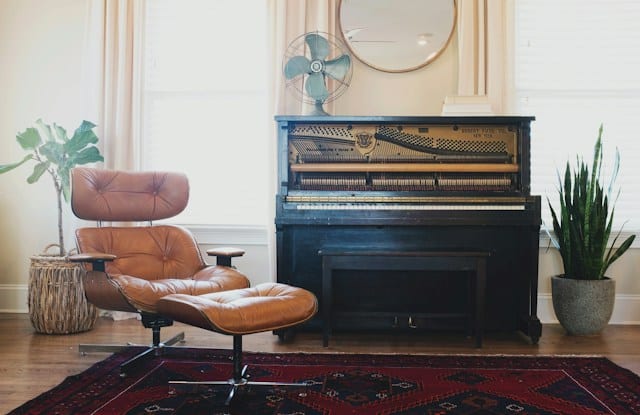As music lovers yourselves, you may have long dreamed of having a dedicated space in your home where you can play your favorite instrument, compose your own melodies, or simply lose yourself in the rhythm of your favorite tracks. A room where, through thoughtful design, you’d be encouraged to enhance your music skills and foster your creativity. If you’ve ever wondered how to design such a space, this article is your complete guide to creating a home music room that inspires practice and creativity.
The Acoustics: Ensuring Sound Quality and Isolation
When designing a music room, the first and foremost concern, undoubtedly, is the acoustics. The sound quality within the room and its isolation from the rest of the house are critical.
Dans le meme genre : How Can You Design an Outdoor Children’s Play Area That’s Safe, Engaging, and Educational?
Those of you who have tried to practice an instrument in a regular room of the house have likely noticed that the sound can be very different depending on the room’s characteristics. Hard surfaces such as glass, metal, and concrete tend to reflect sound waves, causing echo and distortion. On the other hand, soft and porous materials like carpet, fabric, and foam tend to absorb sound waves, reducing echo and providing a clearer sound.
To ensure optimal acoustics, you’ll want to strike a balance between reflective and absorbent materials in your music room. A room too “dead” will stifle your sound, while a room too “live” will distort it. Therefore, consider using absorbent materials on the floors and ceilings, and leave some of the walls hard for a bit of natural reverberation.
Sujet a lire : How Can You Integrate Advanced Lighting Design to Enhance Home Aesthetics and Functionality?
Sound isolation is another important aspect. You don’t want to disturb the rest of the household or your neighbors every time you jam, nor do you want to be disturbed by outside noise when you’re in the zone. Isolation can be achieved by using insulation materials in the walls, ceiling, and floor, and by using double or triple-glazed windows.
The Layout: Ergonomics and Flexibility
Next on the list is the layout of your music room. A well-planned layout can make your practice sessions more comfortable and efficient.
Think about the activities you’ll be doing in the room. Will you be practicing alone, or will there be others playing with you? Will you need space for dancing or moving around? Generally speaking, you’ll want to place your music equipment and furniture in a way that allows for easy movement and interaction.
If you play an instrument like the piano or drums, make sure you have enough space to comfortably reach all parts of the instrument. If you’re a guitarist or a violinist, consider having a comfortable chair and a sturdy music stand. If you’re going to be recording or composing, make sure your desk and chair are at the right height and your computer screen is at eye level to prevent strain.
Flexibility is also key. Maybe today you want to jam with your band, but tomorrow you might want to practice solo, or maybe even host a small concert. Consider using movable furniture and adjustable lighting to easily adapt the space to different activities.
The Aesthetics: Inspiring Creativity
The aesthetics of your music room might not seem as crucial as the acoustics or the layout, but they can significantly impact your motivation and creativity.
Creating an environment that reflects your personal style and your musical taste can inspire you to spend more time in the room and to be more creative. Whether you’re into classic rock, jazz, or electronic music, let your room show it. Decorate the walls with posters of your favorite bands, album covers, or music-related artwork.
Color is another powerful tool for shaping the mood of a room. Light and neutral colors can make a room feel bigger and brighter, which is great for daytime practice. Dark colors can create a cozy and intimate atmosphere, ideal for late-night jam sessions.
Finally, consider the lighting. Natural light is always preferable, but if your room doesn’t have windows, make sure you have enough artificial light. Consider using adjustable lights so you can control the intensity and direction, and maybe even colored lights for those rock-star moments.
The Extras: Amenities and Features
Last but not least, think about the extra amenities and features that can make your music room even more enjoyable and functional.
Do you need storage for your sheet music, records, or audio equipment? Consider adding shelves, cabinets, or drawers. Do you want to record your music? You might need a computer, a sound interface, and a microphone. Don’t forget about the cables, they can easily get out of hand, so consider using cable organizers or cable channels.
Comfort is also essential, especially for long practice sessions. You might want to add a comfortable sofa or armchair for those breaks between sessions. And why not add a small fridge for drinks or a coffee machine for those late-night jam sessions?
In conclusion, designing a home music room that encourages practice and creativity requires a careful consideration of the acoustics, the layout, the aesthetics, and the extra features. By taking into account all these aspects, you can create an inspiring and functional music room that will make your music journey even more enjoyable and rewarding.
The Equipment: Selecting the Right Tools for the Music Room
When building your music room, the type of equipment you choose plays a significant role in making your space conducive for practice and creativity.
The most obvious equipment required for a music room is your instrument or instruments of choice. It could be a piano, a guitar, drums, or even turntables for DJs. It’s crucial to choose high-quality instruments that produce a clear and rich sound.
If you are planning to record your music, you will need to invest in a good quality recording system. This includes a sound interface that can translate the analog signals from your instruments into digital data for your computer. Good quality microphones are essential for capturing your voice or the sound of your acoustic instruments.
Apart from the recording system, you might also need a good set of speakers or studio monitors. These are specially designed speakers that give an accurate reproduction of the sound, which is crucial when it comes to mixing and mastering your tracks.
Accessories are also an important aspect to consider. For instance, if you are a guitarist, you might need a guitar stand and a music stand. For drummers, a comfortable drum throne is crucial. For pianists, an adjustable piano bench would be a good investment.
Lastly, don’t forget about the cables. Keep them organized using cable channels or cable organizers to prevent a messy workspace and potential accidents.
The Maintenance: Keeping the Music Room in Ideal Condition
A music room is an investment, and like any other investment, it requires maintenance to ensure it continues to function optimally.
The first part of maintaining your music room involves taking care of your instruments. This includes routine cleaning, tuning, and periodic professional servicing. For example, pianos should be tuned at least twice a year, while guitars need new strings every three months or so, depending on how often they are played.
Next is the upkeep of your sound equipment. Keep your speakers, microphones, and sound interface free of dust and always ensure your cables are in good condition. Damaged cables can cause noise interference or even damage your equipment.
The physical condition of the room should also be maintained. Check the soundproofing materials regularly to ensure they are still effective. Clean the carpets or floor materials to keep them free from dust, which can affect the room’s acoustics. Ensure the lighting fixtures are functioning properly as well.
Finally, organizing your music room is also part of its maintenance. Keep your sheet music, records, and other materials neatly in their storage areas. Regularly decluttering is also crucial to maintain a conducive environment for creativity.
Conclusion: The Symphony of a Well-Designed Music Room
Designing a music room that encourages practice and creativity is like composing a symphony. Each element, from the acoustics to the layout, the aesthetics, the equipment, and the maintenance, plays a distinct part in the melody. When these components are harmoniously combined, the result is a space that not only inspires but also facilitates musical expression.
Whether you’re a seasoned musician or a beginner, a well-designed music room can make a significant difference in your musical journey. By paying attention to every detail, you can create a space that resonates with your musical passion, a haven where creativity thrives, and where every practice session is a step closer to mastery. Your music room is not just a room; it’s a reflection of your musical soul.






